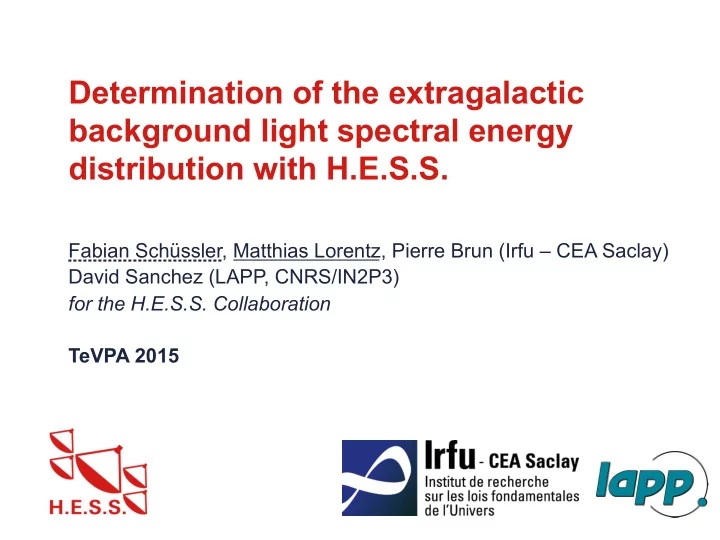

Determination of the extragalactic background light spectral energy distribution with H.E.S.S. Fabian Schüssler, Matthias Lorentz, Pierre Brun (Irfu – CEA Saclay) David Sanchez (LAPP, CNRS/IN2P3) for the H.E.S.S. Collaboration TeVPA 2015
Extragalactic background light and γ -ray absorption § What is the EBL ? Background photon field (IR to UV) originating from starlight and dust re-emission. Direct measurements are difficult ? ¡ § EBL absorbs γ rays by pair creation Universe not transparent to γ rays over extragalactic Courtesy ¡of ¡H. ¡Dole ¡ distances : optical depth τ Attenuation pattern in VHE spectra of distant sources Z z s Z 2 Z ∞ d ✏ dn EBL ( ✏ , z ) dz dt dµµ ⌧ ( E � , z s ) = c � �� ( E � (1 + z ) , ✏ , µ ) 2 dz d ✏ 0 0 ✏ thr Flux ¡ intrinsic ¡ Φ obs ( E γ ) = Φ int ( E γ ) e − τ ( E γ ,z s ) EBL ¡ absorbed ¡ Energy ¡ ~ ¡TeV ¡ Determination of the EBL SED with H.E.S.S. | TeVPA 2015 2 ¡
High Energy Stereoscopic System Khomas ¡Highland, ¡Namibia ¡ § H.E.S.S. phase I : § H.E.S.S. phase II : § 4 telescopes with a 107 m 2 dish § Additional 5 th telescope, 600 m 2 § Cameras with 960 PMTs § Camera with 2048 PMTs § Field of view 5° § Field of view 3.5° § Energy range : 100 GeV to 50 TeV § Energy threshold lowered to ~30 GeV (~10% resolution) See numerous H.E.S.S. contributions at this conference … Determination of the EBL SED with H.E.S.S. | TeVPA 2015 3 ¡
Previous EBL study with H.E.S.S. H.E.S.S. ¡collabora,on ¡(2013), ¡A&A, ¡550, ¡A4 ¡ § Model dependent approach : model of Francheschini et al. 2008 (FR08) § Fixed shape , normalization only § α = 0 : no EBL § α = 1 : EBL normalized to FR08 § EBL detection at 8.8 σ : -0.15 (stat) +/- 0.25 (syst ) α = 1.27 +0.18 § Now, different approach : Can we also determine the shape of the EBL with H.E.S.S. in a model independent way ? Determination of the EBL SED with H.E.S.S. | TeVPA 2015 4 ¡
Spectra : the essential ingredient Φ obs ( E γ ) = Φ int ( E γ ) e − τ ( E γ ,z s ) EBL Measured Hypotheses information needed Example observed spectrum for one data set § Difficulty : disentangle EBL effect and intrinsic curvature § Simple assumptions on intrinsic redshiF ¡ blazar spectra fitted : EBL ¡ dN Power law : dE ∝ E − α dN Intrinsic ¡ dE ∝ E − α − β log( E ) Log parabola : spectrum ¡ Determination of the EBL SED with H.E.S.S. | TeVPA 2015 5 ¡
EBL shape : from splines to envelopes Grid scan : H.E.S.S. spectrum Fit intrinsic + EBL absorption with every shape on the grid Envelope ( χ 2 min +1) Best Fit around best fit spline EBL spline 1 ¡σ ¡contour ¡ Example spectrum and fit Combine all data sets Best ¡fit ¡spline ¡and ¡ ¡all ¡splines ¡inside ¡ ¡( χ 2 min +1) ¡interval ¡ Determination of the EBL SED with H.E.S.S. | TeVPA 2015 6 ¡
A grid to test local EBL shapes § Local (z=0) EBL shapes as splines inside a grid Similar model independent approaches : Mazin & Raue (2007) A&A 471(2), 439-452. § Two grids shifted against each other to Meyer et al. (2012) A&A, 542, A59. reduce constraints on shapes Biteau & Williams (2015), arXiv:1502.04166 Φ obs ( E γ ) = Φ int ( E γ ) e − τ i ( E γ ,z s ) OpHcal ¡depth ¡computed ¡for ¡ every ¡shape ¡on ¡the ¡grid ¡ § i = 0 … 116,640 : # of spline tested § Large variety of EBL shapes allowed § τ also depends on EBL evolution : evolution hypotheses needed § Evolution function extracted from FR08 No significant impact on results compared to simple effective scaling Determination of the EBL SED with H.E.S.S. | TeVPA 2015 7 ¡
Data sample : high significance H.E.S.S. blazars § Cut on significance >10 σ detection with H.E.S.S. § 14 data sets with 6 sources (for now !) O n l y H . E . S . S p . h a § Redshift coverage : z from 0.071 to 0.188 s e - I d a t a u s e d h e r e 1ES ¡1101-‑232 ¡ 1ES ¡0229+200 ¡ 1ES ¡0347-‑121 ¡ PKS ¡2155-‑304 ¡ PKS ¡2005-‑489 ¡ ¡(8 ¡subsets) ¡ H ¡2356-‑309 ¡ (2 ¡subsets) ¡ tevcat.uchicago.edu ¡ Determination of the EBL SED with H.E.S.S. | TeVPA 2015 8 ¡
Preliminary results § The shape of the EBL is accessible § Grey area : combined statistical contour with no assumptions on shape and normalization ! § Systematics : largest contour including x-check analysis + relative exclusion of several data sets Determination of the EBL SED with H.E.S.S. | TeVPA 2015 9 ¡
Summary and perspectives § This study : a 1 st model-independent comprehensive study of the EBL with H.E.S.S. Final study includes : § More sources : § Stronger collective signal § Better redshift coverage § H.E.S.S. II data : § More leverage on short wavelength range § Better assessment of systematics errors § Adaptive grids : from coarse to fine § Other intrinsic spectral shapes assumptions § Influence of EBL evolution § Related study on intrinsic spectra of blazars Coming ¡soon… ¡ H.E.S.S. ¡looking ¡at ¡PKS ¡2155-‑304 ¡ Determination of the EBL SED with H.E.S.S. | TeVPA 2015 10 ¡
Recommend
More recommend